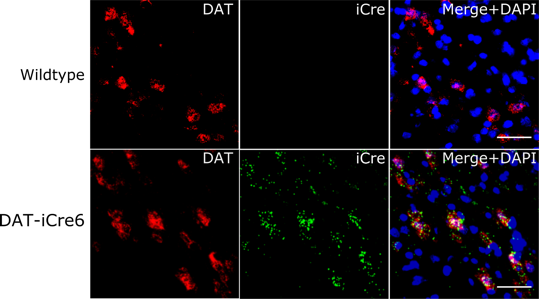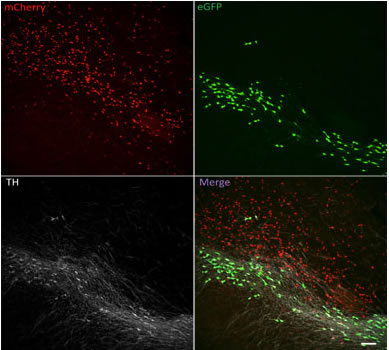Background | Status & Availability | Transgene Info | Breeding | Genotyping | References | Blog/Comments/Reviews | Related rats | Acknowledgements
Background
The dopamine transporter (DAT) protein is selectively expressed in a population of dopaminergic neurons mostly concentrated in the midbrain. Loss of DAT-expressing cells is often a marker of neurodegeneration associated with Parkinson’s disease and methamphetamine abuse. We have generated and characterized a strain of transgenic Long Evans rats expressing iCre recombinase under a DAT promoter (DAT::iCre, line 6). The tissue-specific expression of iCre can be used in combination with Cre-dependent transgenes to obtain selective expression of transgenes in DAT(+) neurons.
Status and Availability
This rat has been published (PMID: 30792150).
As of May 17, 2016, this strain is available as line #00758 at the RRRC.
This rat is registered at the Rat Genome Database (RGD) ID# 9588578.
Transgene Information
Figure 1: Schematic of DAT-iCre transgenic construct. A bacterial artificial chromosome (BAC) containing the rat DAT gene (CH230-275E16) was obtained from the Children’s Hospital Oakland Research Institute (CHORI), and recombineered to replace the start codon of DAT with cassette containing iCre (improved Cre recombinase) and the polyadenylation signal from the gene for bovine growth hormone (pOTTC173). This BAC was injected into the pronuclei of fertilized Long Evans rat embryos by NIMH Transgenic Core, and ultimately resulted in three independent, phenotypically positive DAT::iCre lines. This line (LE-Tg(DAT-iCre)6Ottc) has one copy of the transgene per haploid genome as determined by droplet digital PCR.
Phenotypic Characterization
Figure 2: RNA expression patterns of DAT (red) and iCre (green) in the midbrain. Labeling of target mRNA was done by in situ hydridization with fluorescently-labeled RNAscope probes. Wildtype rats show no iCre expression, whereas transgenic DAT-iCre6 rats show iCre expression only in cells that also express DAT. The nuclei of all cells are stained with DAPI (blue). Scale bar represents 50 microns.
Figure 3. Midbrain expression of tyrosine hydroxylase (TH) and red to green fluorescent protein reporters of Cre activity. Two weeks after injection of AAV-Nuc-flox(mCherry)-eGFP into the substantia nigra of a DAT-iCre6 rat brains were sections and immunostained for TH as a reliable marker for dopaminergic cells. Transduced cells that do not express iCre are red because they only express nuclear-localized mCherry, whereas transduced (dopaminergic) cells which express iCre are green because the viral genome has recombined to delete the mCherry coding region. The nuclei of all cells are stained with DAPI (blue). Scale bar represent 50 microns.
Breeding Strategy
Breeding Information, click here for PDF
Genotyping Assays
Assay for the presence of DAT-iCre insert, click here for PDF
References that cite this rat
2019
Neuron-Specific Genome Modification in the Adult Rat Brain Using CRISPR-Cas9 Transgenic Rats. Journal Article
In: Neuron, vol. 102, no. 1, pp. 105–119, 2019, ISSN: 1097-4199 (Electronic); 0896-6273 (Linking).
Blog/Comments/Reviews
Last Updated on November 12, 2024
There are 4 surveyed reports for the receiving and usage of Long Evans transgenic DAT iCre rats.
General Health
There are no reports of general health issues with the LE-Tg(DAT-iCre)3Ottc rats
Weight
There are no reports of weight changes with the LE-Tg(DAT-iCre)3Ottc rats
Breeding
There are no reports of breeding issues with the LE-Tg(DAT-iCre)3Ottc rats
Expression
There are no reports of expression issues with the LE-Tg(DAT-iCre)3Ottc rats
LE-Tg(DAT-iCre)6Ottc
There have been no reported issues with the Long Evans transgenic DAT-iCre rats.
Other related rats
Registered Symbol: LE-Tg(DAT-iCre)1Ottc
RGD ID: 9588572 ![]()
Proposed Name: LE-Tg(DAT::iCre)1Ottc
RRRC#: 758 ![]()
Acknowledgements
YaJun Zhang, Julie Necarsulmer, Pyry Koivula, Christopher T. Richie, Brandon Harvey, Janette Lebron



